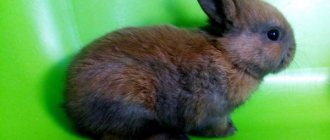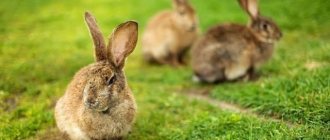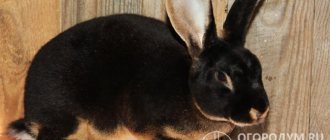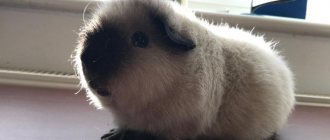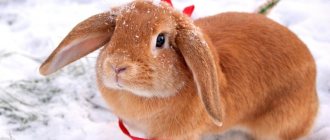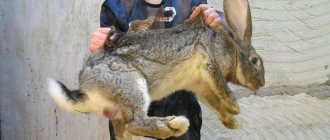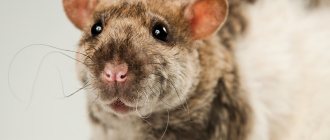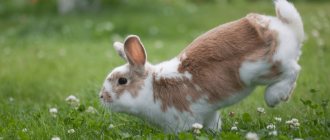In rabbit breeding, the term “Rex” unites several different breeds, representatives of which have luxurious plush fur. Only some of them grow large enough and are bred for meat or skins, while others are miniature in size and kept as pets.
Let's figure out what dwarf rex rabbits are and how to care for them.
Appearance
Dwarf Rex rabbits were obtained through careful selection. To reduce weight, blood from representatives of miniature varieties was added to the original breed.
As a result of hard work, an officially approved European standard appeared in 1992, which contains a clear description of the dwarf rex.
Interesting! Translated from Latin, rex means “royal.” The rabbit earned this name thanks to its luxurious plush fur.
According to the current standard, a typical representative of the breed must have the following anatomical features:
- Average weight – 0.6-1.5 kg.
- The head is short and large.
- The ears are erect, rounded at the tips. The length of the canvas is 45-55 mm.
- The mustache is short and broken.
- The body is stocky, cylindrical in shape, with an indistinct dewlap.
- The tail is short.
- The hind limbs are noticeably longer than the forelimbs.
- The fur is short and dense. The optimal hair length is 1.4-1.7 cm. The colors of Rex rabbits are very diverse. The standard allows more than 25 color variations. The most popular are white, blue, black, brown and two-color Rex. Less common in the breed are tricolor, fiery red, silver and speckled rabbits.
On a note. The list of existing colors continues to expand. Thus, in 2012, thanks to the efforts of breeders, Rex rabbits with the “silver marten” coloring were bred.
History of the breed
The appearance of a litter of chestnut rabbits from gray rabbits aroused the extraordinary interest of breeder A. Gillette, who decided to keep the unusual animals to try to breed them in the future. Because of their brown color, they decided to call the animals “castors” (beaver rabbits). At that time, scientists could not yet accurately explain this modification, but now the cause has already been clearly established - a gene mutation.
As a result of 5 years of experiments, the first Rexes were presented at the 1924 zoological exhibition in Paris. The long-eared animals were a fabulous success among the participants of the congress, and they were officially given the status of a separate breed, and the basic Standards of the species were prescribed.
| → mutation of the dominant R (normal type of fur) to the recessive gene r (short hair and its curliness) → | Rex + Netherland Dwarf Rabbit→ Dwarf Beaver Rex |
|
But the breeders did not stop there. As a result of crossing the Dutch dwarf breed with Rex, miniature copies of their parents were born. The decorative breed received official recognition at the end of 1966. But the study of the species and its selection does not stop to this day. As a result of many year-long experiments, about 20 species of Rex were obtained.
Character and behavior
The dwarf rex is a rabbit with a calm, phlegmatic temperament. He is very timid and needs to be handled with care. The dwarf rex is afraid of loud and sharp sounds. He has a very developed sense of smell and can be frightened by foreign smells.
The mini rex rabbit takes a long time to get used to its new environment, but after adaptation it becomes very good-natured. He gets along well with all family members and other pets. The nimble, fussy animal loves to mischief.
Left unattended, a dwarf rabbit will definitely start gnawing on everything it can get its hands on.
Decorative Rex is endowed with high intelligence and is easy to train. He quickly gets used to his name and learns to use the litter tray without any problems.
Health and life expectancy
The Rex rabbit breed does not belong to the category of long-livers. The average life expectancy of dwarf animals is 5-6 years. Although there are cases when they lived up to 8-10 years.
Rex rabbits are endowed with fairly strong immunity. But the breed has a predisposition to the following diseases:
- myxomatosis;
- rabies;
- hemorrhagic fever;
- pododermatitis.
Prevention of these diseases is timely vaccination and maintaining cleanliness in the cage.
Breeding Rex rabbits
When purchasing Rex rabbits intended for breeding, you should be careful not to purchase a fake. Characteristic features are curved whiskers, even and smooth hair, evenly distributed throughout the body. You should stroke your future pet and make sure that after this the fur has returned to its previous position.
Particular attention should be paid to the condition of the fur. It should be soft to the touch. There should be no receding hairline or bald spots. The body must be strong enough; thinness may indicate the presence of diseases.
Females have a low fertility rate. For one birth they bring no more than 5-6 rabbits. Female rabbits are good mothers and immediately begin feeding their babies with enthusiasm.
When keeping a Rex rabbit in an apartment, it is necessary to provide it with a spacious cage with a shelter inside it, where it can hide and rest. You should regularly let him wander around the apartment, after removing wires and other objects that he can chew. It is possible to purchase special toys for him. We should not forget that rabbits need the attention of their owners.
Care and maintenance
Decorative rexes do not require complex care. The air temperature in the room where dwarf rabbits live should be between 15-25 °C with a humidity of about 50%. Otherwise, caring for rabbits of this breed differs little from caring for representatives of other species.
Home improvement
For home keeping, the dwarf rex is given a spacious, durable cage with a solid floor and closely spaced bars. It will be equipped with a closed drinking bowl, a heavy ceramic feeder, a tray for going to the toilet and a house in which the animal can retire.
A cage for a decorative rabbit is installed in a shaded, well-ventilated place, away from drafts, direct sunlight and heating appliances. The floor is covered with bedding, which is changed at least once every 2-3 days.
On a note. To ensure that the rabbit does not lack exercise, it is regularly released from the cage. To avoid possible injuries and damage to the owner's property, all electrical wires are hidden in the room in advance.
The dwarf rabbit is offered balls and cardboard boxes as toys.
Hygiene procedures
To ensure that Rex rabbits look neat, they are provided with appropriate care:
- The eyes of dwarf animals are examined daily for redness or any unusual discharge and wiped with a cloth soaked in warm water.
- Rex ears are regularly cleaned with a cotton swab moistened with a weak solution of boric acid.
- The fur of dwarf rabbits is brushed weekly with a brush with natural bristles and protected from getting wet.
Taming
The dwarf rex is quite shy and does not immediately make contact. In order for the rabbit to quickly get used to its new owners, you need to talk to it more often in a calm, quiet voice and treat it with your favorite treats. Once contact has been established, you can try petting your pet.
Important! When communicating with a rabbit, you should not use strong-smelling perfumes and cosmetics. A strong smell can scare off your dwarf rex or make it aggressive.
To avoid harming the rabbit, it should not be lifted by the ears. You need to pick up the dwarf rex correctly: with one hand you clasp the chest under the front legs, and with the other you support the lower part of the body.
“His beaver collar is silver with frosty dust...”
Visually, the fur of a “beaver” is very similar to a shorn beaver - just as beautiful and elegant, the only difference is durability and price. The fur of the Red Book beaver is one of the most expensive: it is not afraid of moisture, and under wet snow it becomes even fluffier. Its qualities surpass even the skin of mink and sable - with a dense downy undercoat and durable guard hair. Products made from beaver skins can be a bit heavy to wear, but this only happens when the workmanship is of poor quality (in general, beaver fur coats are made without an insulating lining for lightness).
Be careful: beaver and beaver are not the same thing!
You can distinguish a “beaver” from a “beaver” by touch: run your hand against the fur - you will feel a hard pile, like needles. The velvet “beaver” will be soft and silky if you stroke it in different directions, but the pile is not so thick and there is no shine in it.
In fact, “beaver” is a very attractive alternative when there is not enough money to buy “mink” or “chinchilla”. “Velor rabbit” easily tolerates wet snow, is easy to clean and retains heat (down to minus 25 degrees). And, if you put on a warm blouse, it will protect you even in severe frosts.
Feeding
The dwarf rex's diet should be of high quality and well-balanced. The diet of a rabbit of this breed should include:
- fresh, slightly dried herbs;
- twig feed;
- silage, field and meadow hay;
- ready-made feed;
- seeds and dried fruits (in winter);
- roughage;
- fresh root vegetables, vegetables and fruits.
Legumes, tomatoes, mushrooms, eggplants, sweets, onions, garlic and some types of cabbage (red and white) are extremely contraindicated for Rex rabbits.
Reproduction and offspring
Dwarf rexes are a fast maturing breed. Females become sexually mature at 4-5 months and bear offspring several times a year. But due to the fact that in the process of breeding the breed, closely related crossings were often carried out, newborn rabbits often die.
To obtain strong offspring, experienced breeders recommend using completely healthy and vaccinated individuals whose weight is at least 1 kg and no more than 1.6 kg. In order for mating to be successful, the female is placed in the male’s territory and left there without food or drink.
If fertilization is successful, in about a month the female rabbit will give birth to 4-5 helpless and blind babies. During the first weeks, the cubs feed exclusively on mother's milk. But as soon as the rabbits turn 21 days old, complementary foods are gradually introduced into their diet.
Productive qualities
The weight of an adult rex can reach 5 kg. Due to the fact that it has light bones, most of the live weight is dietary and very tasty meat. Rex gains weight relatively quickly: 2 – 2.5 kg in 4 months. But other breeds of this type are more often bred for meat.
Find out how to fatten a rabbit for meat in a short time.
Royal rabbits are more prized for their original fur. In addition to high aesthetic qualities, it is very practical. The fur coat is denser than the furs of other breeds and is more wear-resistant. In addition, due to its special texture, the rex skin can be confused with the fur of more valuable fur-bearing animals. Therefore, it is highly valued among fur manufacturers.
How to choose a pet
To become the owner of a purebred and absolutely healthy Rex rabbit, it is recommended to buy an animal from trusted breeders. It is advisable to take your pet to a new home no earlier than he is 60 days old. At the time of purchase, the dwarf rabbit must have a veterinary passport with vaccination records and a pedigree.
When purchasing a Rex, you also need to pay attention to:
- on conditions of detention;
- behavioral characteristics;
- visual compliance with the breed standard;
- health status.
The Dwarf Rex is easily distinguished from other breeds by its shiny plush coat and short, broken mustache.
The following signs indirectly indicate the health of a rabbit:
- clean ears (no crusts or discharge);
- clear, non-watery eyes;
- no dirt under the tail;
- thick, shiny, not tousled coat;
- smooth skin without scratching, rashes and redness.
On a note. If you lift a healthy baby rabbit by the scruff of the neck, its body will tense like a spring, and not sag like a sack.
Rex rabbits are small funny animals with short ears and short plush fur. Representatives of the breed easily get used to hands and do not cause much trouble. Therefore, they are often kept as pets.
Purchase
Pets should be purchased when their baby teeth are replaced. You cannot buy babies who are less than 30-40 days old. When purchasing, you need to make sure that the type is original.
To do this, you need to pay attention to parameters that are in no way inherent to this type:
- Body weight less than 3 or more than 5.5 kg;
- Various deviations in the constitution of the body;
- Severe pointedness, excessive thinness or drooping of the ears;
- Clumpy, sparse coat with bald patches;
- Ear length more than 13 cm;
- Hair length more than 24 mm;
- The hair on the ears is poorly developed;
- the presence of a double or triple chin.

